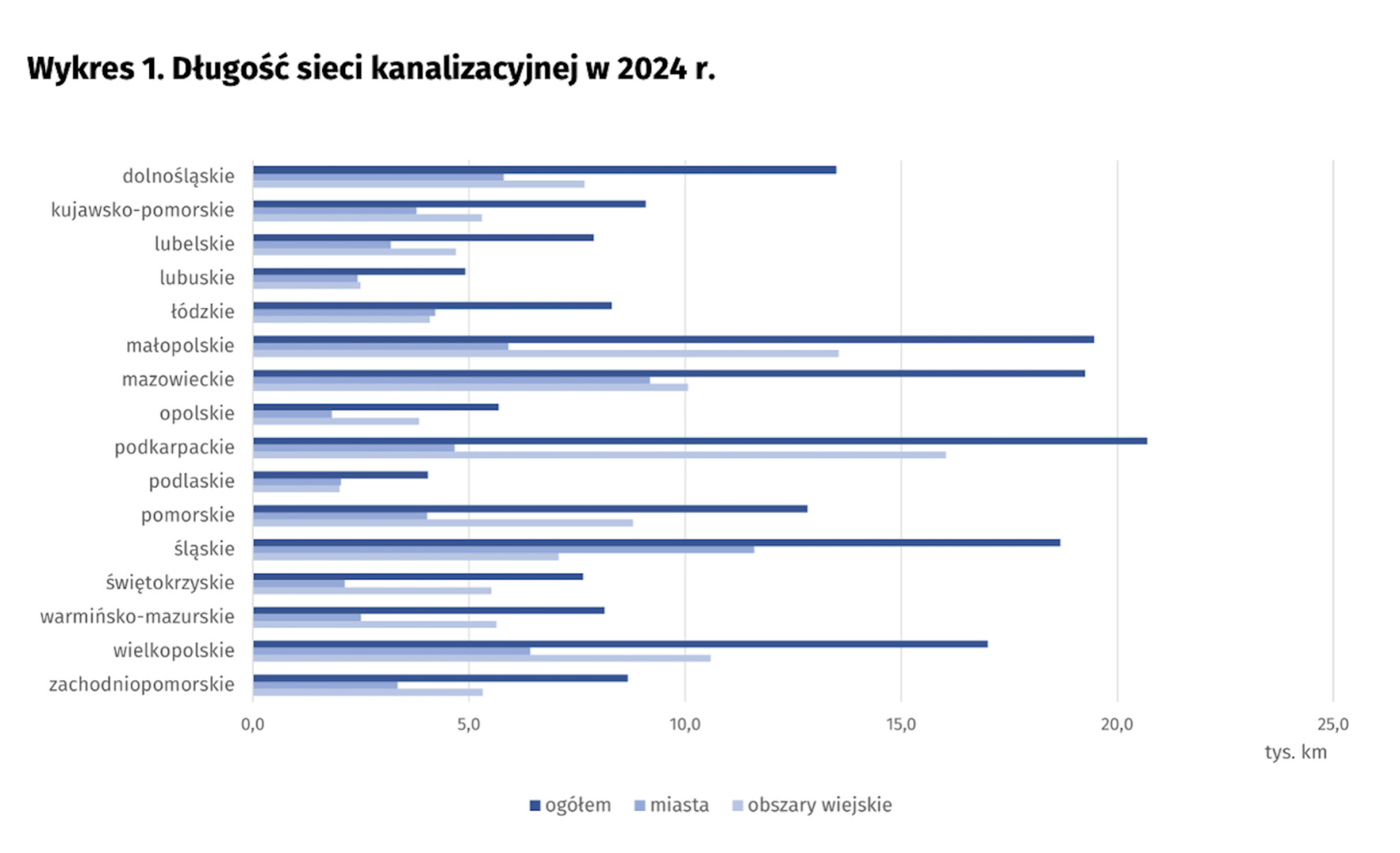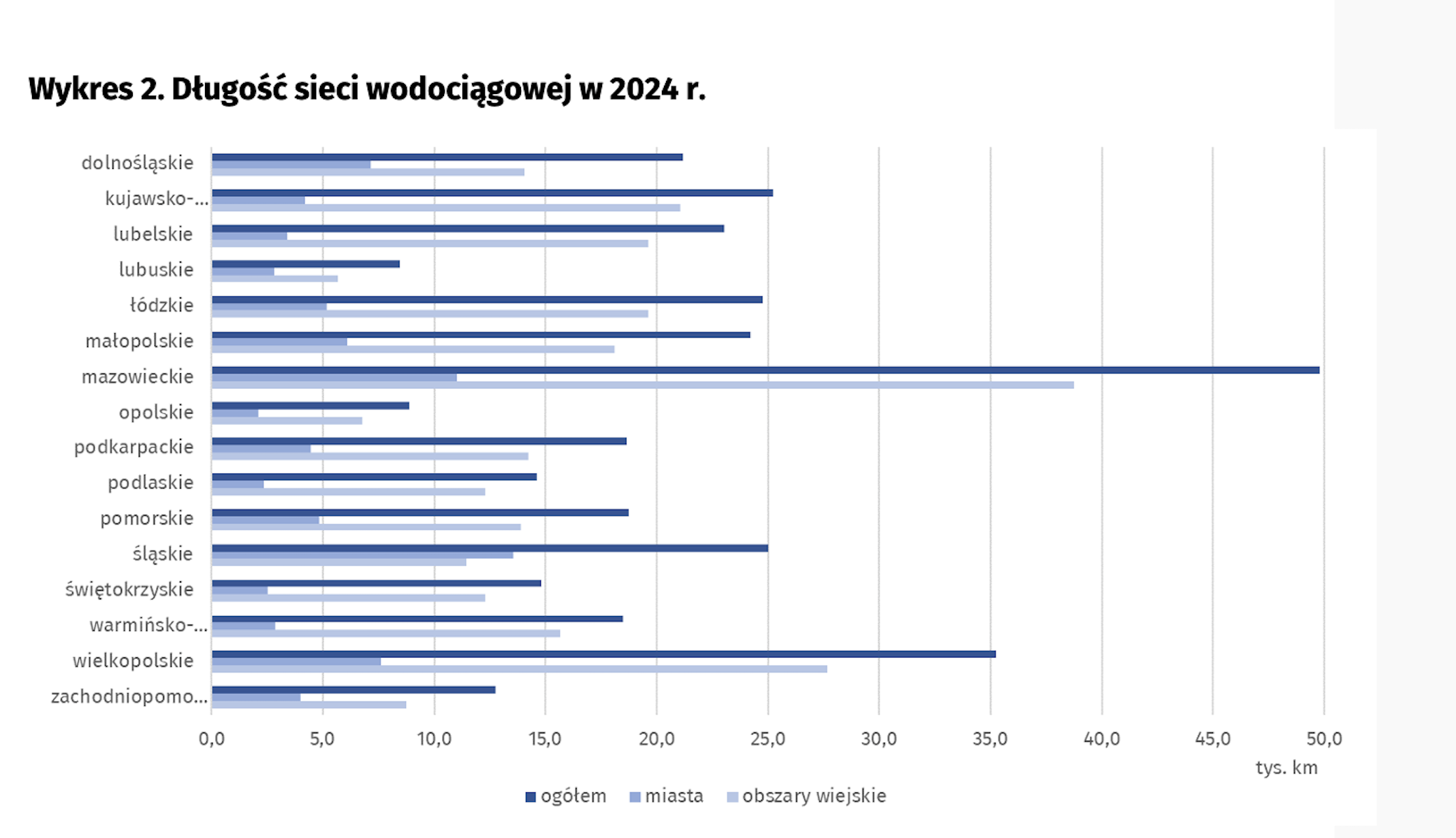It's better. There is no longer a water and sewage gap in Poland

- - Compared to 2023, the number of connections to residential buildings increased by 2.8% in 2024 - informs the Central Statistical Office.
- The amount of sewage discharged from households increased by 2.5% in 2024 compared to the previous year.
- In 2024, 60.7% of the entire sewage network was located in rural areas.
- The most significant increase in the length of the sewage network compared to 2023 was recorded in the following voivodeships: Małopolskie, Lubelskie, Podlaskie and Świętokrzyskie.
On June 27 this year, the Central Statistical Office published the latest report on the condition of the water and sewage infrastructure in Poland .
Data collected by the Central Statistical Office show, among other things, that at the end of 2024, the sewage network in Poland reached a length of 185.8 thousand km, and the number of connections to residential buildings - 4 million pieces.
Compared to 2023 , the length of the constructed or reconstructed sewage network increased in 2024 by approximately 4.3 thousand km, i.e. by 2.4% , with a simultaneous increase in the number of connections to residential buildings by almost 112 thousand pieces, i.e. by 2.8%.
- informs the Central Statistical Office.
Rural areas had 60.7% of the sewage network and 47.6% of all sewage connections to residential buildings. Compared to the previous year, the length of the network in rural areas increased by almost 3.1 thousand km (by 2.9%), and the number of connections to residential buildings by almost 62.2 thousand pieces (by 3.3%).
In cities, 1.1 thousand km of networks were built (an increase of 1.6%) and almost 50.0 thousand connections to residential buildings (an increase of 2.4%).

In 2024, in the voivodeship system, the most significant increase in the length of the sewage network compared to 2023 was recorded in the following voivodeships : Małopolskie - by 3.2%, Lubelskie, Podlaskie and Świętokrzyskie - by 3.1% each, while the smallest in Kujawsko-Pomorskie - by 1.1% and Lubuskie - by 1.2%.
The highest density of the sewage network at the end of 2024 was recorded in the following voivodeships: Silesia - 151.5 km per 100 km2 and Lesser Poland - 128.2 km per 100 km2, while the lowest in the following voivodeships: Podlaskie - 20.1 km per 100 km2 and Lublin - 31.4 km per 100 km2.
At the end of 2024, the percentage of residential buildings connected to the sewage system in the country was 54.9%, which is 0.9 percentage points higher than in 2023. In cities, 77.7% of residential buildings were connected to the sewage system, while in rural areas - 41.3%.
The amount of sewage discharged from households through the sewerage network in 2024 amounted to 1,027.0 cubic hm (in cities - 881.2 cubic hm, and in rural areas - 145.8 cubic hm) and increased by 25.0 cubic hm compared to 2023 (in cities 22.9 cubic hm, and in rural areas by 2.1 cubic hm).
75.5% of the length of the water supply network was located in rural areas.Data from the Central Statistical Office show that the differences in water and sewage between rural areas and cities are being eliminated at an increasingly rapid pace .
At the end of 2024, the length of the water supply network (distribution and main) reached 343.9 thousand km, and the number of connections to residential buildings - almost 6.4 million pieces. Compared to 2023, the length of the constructed or reconstructed water supply network increased by 2.8 thousand km (by 0.8%), at the same time an increase in the number of connections to residential buildings was observed by 106.9 thousand pieces (by 1.7%).
- reports the Central Statistical Office.
It is noted that 75.5% of the length of the water supply network and 62.0% of connections to residential buildings were located in rural areas . Compared to the previous year, the length of the water supply network in rural areas increased by 1.8 thousand km (by 0.7%) and amounted to almost 260.0 thousand km, while the number of connections to residential buildings - by 58.8 thousand pieces (by 1.5%).

In cities, on the other hand, the network increased by 0.9 thousand km (an increase of 1.1%) and its length amounted to 84.1 thousand km, while the number of connections increased by 48.0 thousand units (an increase of 2.0%).
The Central Statistical Office indicates that the largest increase in the water supply network compared to the previous year was observed in the following voivodeships : Zachodniopomorskie - by 1.6%, Pomorskie - by 1.5% and Podkarpackie - by 1.4%, while the smallest was recorded in the following voivodeships: Łódzkie - by 0.3% and Lubuskie and Opolskie - by 0.5%.
- At the end of 2024, the percentage of residential buildings connected to the water supply network was 86.0% and compared to 2023 it was higher by 0.2 percentage points. In cities, 88.7% of residential buildings were connected to the water supply network, while in rural areas - 84.4% - reports the Central Statistical Office.
portalsamorzadowy




